โปรดเลือกตำแหน่งที่ตั้งและภาษาของคุณเพื่อรับประสบการณ์เว็บไซต์ที่ดีที่สุด

In the barcode labeling industry, there are many types of barcodes, known as barcode symbologies. Symbology is defined as the study or interpretation of symbols. Understanding what each barcode type stands for and how each character is read together is important, otherwise, if the symbols separate, the barcode becomes invalid.
TEKLYNX barcode labeling software helps you design accurate barcode labels to meet industry standards. Use over 100+ barcode symbologies available in TEKLYNX label design software, plus try our helpful wizards for creating your barcodes. If you’re ready to start designing labels today, download a free 30-day trial of LABELVIEW.
Barcode symbologies differ by the type of data they hold and are encoded with. In this blog, we go over the categories of barcodes, the most common types of barcodes, and how to choose the best one for your labels.
With over 100 different barcode symbologies, there are quite a few common barcode types you may use and recognize. Barcodes are broken down between 1D and 2D, GS1, Postal, and Composite barcodes.
The two main categories of barcodes are 1D and 2D barcodes.
1D barcodes, also known as linear barcodes, are one of the most common barcodes used on consumer goods. They have vertical bars lining up and down, containing around a dozen characters (depending on the type) that encode specific data and are scanned horizontally. Some common 1D barcodes you may use and recognize are UPC codes, EAN, Code 39, and more.
2D barcodes have a two-dimensional representation of the data. They are shaped like squares or rectangles, consist of vertical and horizontal bars, and have the capability to store and encode more data in a smaller space. 2D barcodes have many purposes such as storage for UPC codes, importing or exporting data, and sharing URL links.
Choosing the correct barcode type such as 1D or 2D depends on the type of data you need and the amount that is required on the barcode. 1D barcodes are often used in grocery stores where the product information or shipping container is constantly being updated. 2D barcodes are often used when space for the barcode is limited, and when larger amounts of data are required.
TEKLYNX barcode software includes categories for 1D (linear) and 2D, GS1, postal barcodes, as well as composite (made up of two stacked barcodes) to help users easily find the barcode symbology they are looking for. These barcode categories aren’t mutually exclusive and may overlap with each other. For example, a barcode can be both a 1D barcode and a GS1 barcode.
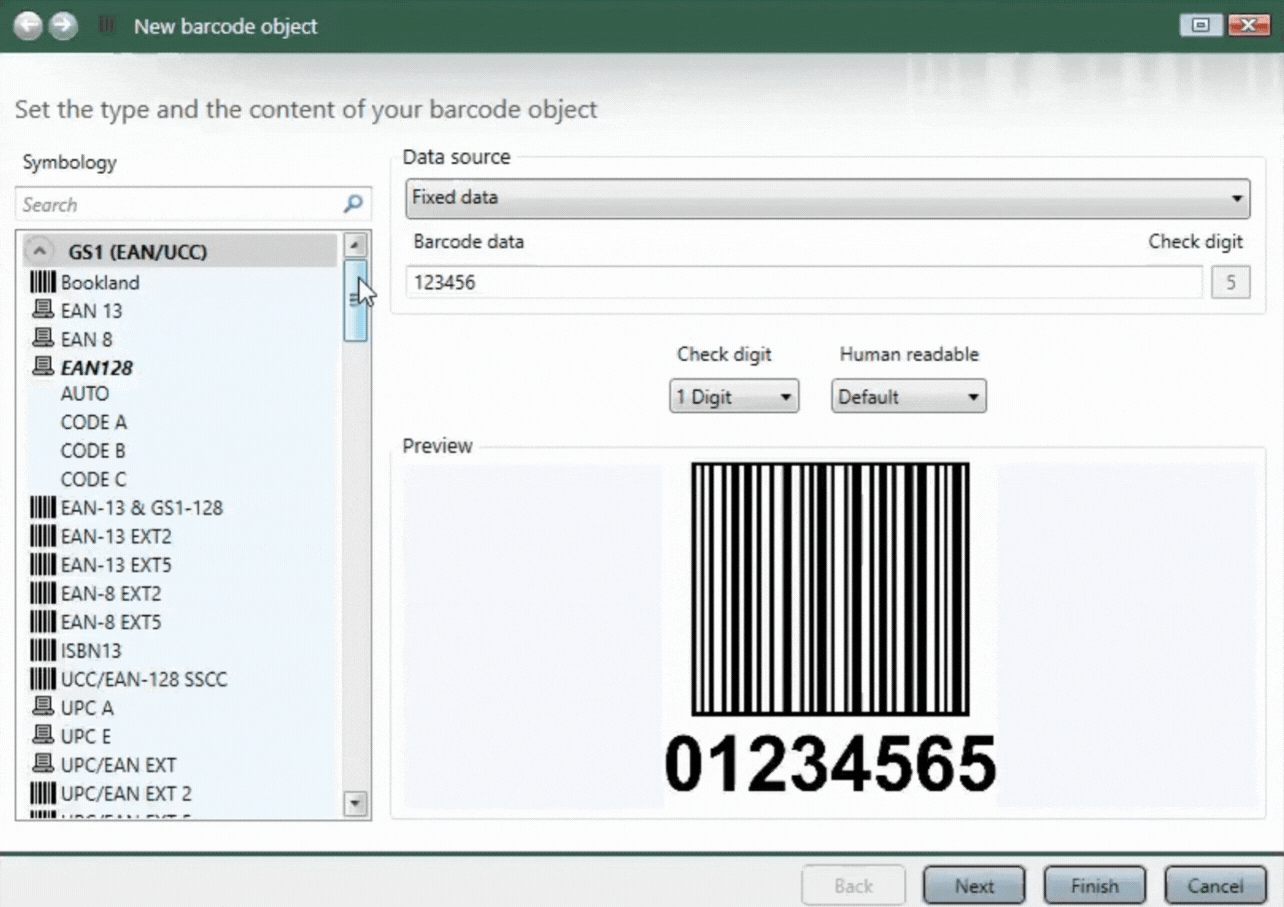
One of the most common 1D barcodes is UPC-A. You may recognize a UPC-A barcode at your local grocery store or when you are shopping at the mall.
Did you know that the first barcode ever scanned was a UPC barcode on a pack of Wrigley’s Juicy Fruit chewing gum?
UPC barcodes contain 12 digits: the first set of numbers uniquely identifies a company, the second set is the item reference which helps track items in inventory, and the last is the check digit number. The check digit is calculated using the other numbers on the barcode and an algorithm. If the check digit doesn’t match the numbers that were calculated, an error will be identified. Having a check digit calculator built into your barcode software makes this process super easy and efficient!
As you can see in the example below, there are no special characters or letters used on a UPC-A barcode, only numerical data. UPC-A is often used in shipping, manufacturing, and warehouse and distribution industries, but is ideal for grocery and retail stores as they are smaller barcodes and encode a limited amount of data.
The graphic below explains what each set of numbers on a UPC barcode means.
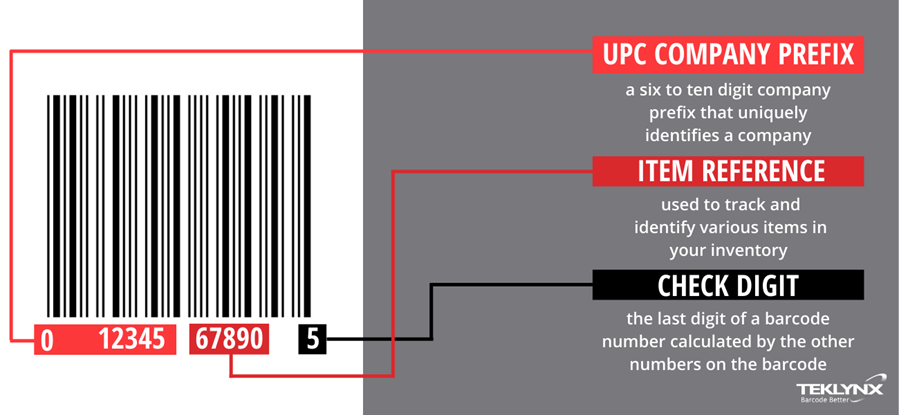
Code 39, also known as Code 3 of 9, is another common linear 1D barcode. It was the first alphanumeric symbology and the oldest barcode symbology to be developed, dating back to 1974. Code 39 is not as compact as Code 128, requiring more space on the barcode label. It encodes up to 44 alphanumeric characters: numbers zero to nine and the letters A-Z, with some special characters. Some popular industries you may see using Code 39 barcodes are the automotive industry, electronics, warehousing, and manufacturing.
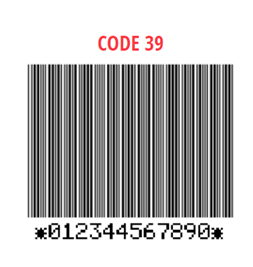
Code 128 is another versatile 1D barcode including numerics, alphanumerics, punctuation, symbols, and more. ASCII stands for American Standard Code for Information Interchange; it is a character encoding standard for communicating electronically. LABELVIEW and CODESOFT both feature a quick-reference ASCII table in the formula tool, helping users look up the values without leaving our software. Each Code 128 barcode can encode any of the 128 ASCII characters, including three black and three white bars spaced in each symbol. Along with Code 128 barcodes, there are subtypes such as Code 128A, Code 128B, and Code 128C. These all consist of varying data, such as lower-case letters, capital letters, punctuation, and encoded numbers.
GS1-128 is a version of a Code 128 barcode that usually includes serial numbers and expiration dates; this helps the traceability of items through a supply chain.
If you are in the retail industry, or shipping industry you will most likely be using a Code 128 barcode, while GS1-128 barcodes are very common in shipping, food & beverage, retail, healthcare, and the medical device industry.
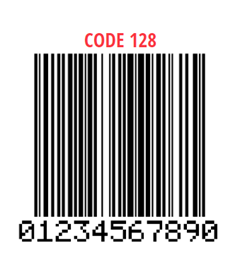
GS1 Databar omnidirectional barcodes are high-density 1D barcodes, that are smaller than UPC-A but can hold up to 14 characters compared to 12. The 14 digits allow the GS1 Databar to hold the maximum length Global Trade Item Number (GTIN). This provides identification for products across all organizations and databases. Omnidirectional barcodes can be scanned at any given angle helping processes to stay efficient, but also can be stacked or combined with other barcodes creating Composite barcodes.
It’s common to use a GS1 Databar barcode to label fresh food since they include batch numbers and expiration dates for the food. The GS1 Databar barcode is also used in the retail industry and can be read by a simple laser scanner.
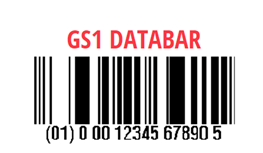
QR codes fall under 2D barcode symbologies. QR codes stand for “Quick Response Code”, as their speed to be read is the top advantage. They are commonly used to direct users to a specific URL link, social media page, or coupon.
Since the rise of the COVID-19 pandemic, more contactless solutions were introduced to slow the spread of germs; QR codes became more popular. Many restaurants now use QR codes instead of menus. If you scan the QR code on the table, it will take you directly to that restaurant's website for their menu. Another popular industry you may see QR codes in is the retail industry, where they are used for coupons, forms of payment, or loyalty programs, making it easy for the average consumer to scan with their smartphone.
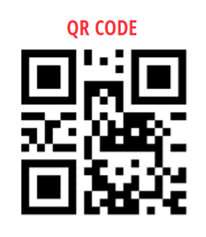
Data Matrix, another type of 2D barcode, is made up of black and white modules, or cells, that are arranged in a square pattern. TEKLYNX software allows the codification of up to 2,335 ASCII characters. Since Data Matrix barcodes are more complex than the average 1D linear barcode, they can only be read by specific 2D camera scanners.
Data Matrix barcodes are common in the pharmaceutical industry to help comply with FDA 21 CFR Part 11 and the Drug Supply Chain Security Act (DSCSA). They are also found in food & beverage and defense industries where track and trace are critical in supply chain operations.
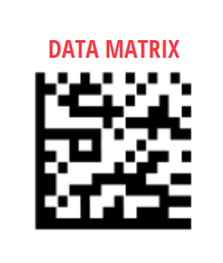
PDF417 is also a part of the 2D barcode family. PDF417 is a linear stacked barcode that is very popular on the United States driver’s licenses and is also used in the transportation/automotive, pharmaceutical, and manufacturing industries. The number 417 comes from four bars and four spaces on the barcode and 17 units long. The data in these units can be encoded vertically or horizontally and the more data that is encoded, the larger the barcode may get.

GS1 is a global not-for-profit organization that provides the framework for real-time product identification, tracking, traceability, and supply chain efficiencies. Many of the barcodes listed above can be a form of GS1 barcodes such as UPC, GS1-128, GS1 DataBar, QR codes, GS1 Data Matrix, and more! Industries such as retail, food & beverage, shipping, pharmaceutical, automotive, and many others use GS1 barcodes. TEKLYNX has a built-in GS1 barcode generator wizard for GS1-compliant barcode creation. Watch our webinar on Creating GS1 barcodes in CODESOFT and LABELVIEW. Designing accurate GS1 barcodes is crucial for day-to-day operations of businesses around the globe.
Ready to start creating GS1 barcodes for your products? Get started by licensing a GS1 Company Prefix or a GS1 US GTIN. TEKLYNX partners with GS1 US so you can get authentic UPC Numbers (GTINs) directly through GS1 US by clicking the appropriate link below. You will be taken directly to the GS1 US store. When completed, come back to TEKLYNX and discover GS1-compliant barcode label design software.
Other than the data barcodes hold and the shape they contain, 1D and 2D barcodes must be scanned differently. 1D linear barcodes are scanned by any original barcode scanner that uses an LED or laser light. 2D barcodes must be scanned by a barcode imager, like a camera. It reads the 2D barcode, takes an image of it, and then sends the data to a computer to be read. Make sure you know which types of barcodes are compatible with your scanners (or the scanners of your customers) for accurate readability.
1D barcodes are very common, but recently we are seeing more industries adopt the usage of 2D barcodes. Since they can encode more information, 2D barcodes are up for greater demand because they have greater production information transparency, traceability, and authentication. 2D barcodes are not only improving inventory management but are allowing for greater sustainability in supply chain operations. GS1 has released expectations for the transition from 1D to 2D barcodes being accepted for point-of-sale, referred to as Sunrise 2027. Learn more about the transition and what to expect.
Barcodes are the backbone of supply chain operations. The barcode types in this blog are just a few of the common barcode types you may see, but TEKLYNX barcode label software products have over 100 barcode symbologies you can utilize in many different industries.
Understanding each barcode symbology is important in creating an accurate barcode for your industry to meet regulatory compliance. The type of barcode you may need to create will most often be defined internally, by labeling regulations, or by your buyers or customers.
Having a labeling partner that helps you meet these regulations is critical in the dynamic barcode labeling world. Download a free 30-day trial of LABELVIEW label design software to start leveraging barcodes on your labels or if you’re unsure of which barcode type fits your labeling needs, get in touch with a TEKLYNX labeling expert today!
Travis Wayne is the Product Manager at TEKLYNX. Travis applies his 20+ years of IT and health sciences experience to empower businesses to streamline operations and barcode better by applying software and technology. He works to continually improve TEKLYNX strategic planning, product and project management principles, and cross-functional communications. When not working, he enjoys many outdoor activities with his wife and two children.
Merriam Webster says a barcode is “a code consisting of a group of printed and variously patterned bars and spaces and sometimes numerals that is designed to be scanned and read into computer memory and that contains information about the object it labels.” While it’s great to know the technical definition of the word, what does that mean for you and your business?
READ MORE
Jenna Wagner, Director of Marketing at TEKLYNX, sat down with James Urquhart, Director of Partnerships for GS1 US, to gain his perspective and insights on this movement. Read further to learn what he had to say on what the future may hold for 1D versus 2D barcodes.
READ MORE
There is a common misconception that creating and leveraging barcodes is an expensive or time-consuming investment when in reality there are barcode label software solutions with low up-front costs that are easy to install and use, plus pave the way for scalability as your company grows.
READ MORE© Copyright 2025 TEKLYNX CORPORATION SAS. สงวนลิขสิทธิ์
What do you think? Leave us a comment.
Comments will be reviewed and are subject to TEKLYNX’ comment policy. Your email address will not be published publicly.